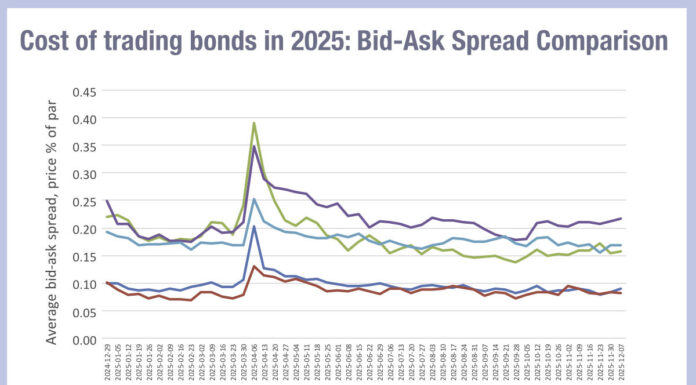By Pia Hecher.

Seth Johnson, chief executive officer of NEX Markets, operator of US Treasury marketplace BrokerTec, talks about the firm’s data distribution strategy, including the push to buy-side firms through the Bloomberg Capital Markets Package (BCMP).
What effect will the new relationship have on data consumption?
We had a 15-year exclusive relationship with Thomson Reuters and recently decided to change our channel strategy as we thought it appropriate to make our data more widely accessible to the market.
As a consequence, the input to Telerate 19901 changed from us BrokerTec to Dealerweb, which is owned by Thomson Reuters. We decided to build what we feel to be a superior product in BCMP, the most liquid and transparent US capital market reference available, representing the two largest electronic wholesale markets in UST and IRD – NEX’s BrokerTec US Treasuries data with USD Spread-Over data from Tradition’s Trad-X platform. BCMP is now available through Bloomberg to a wider audience than was previously able to consume it.
Equally important is that BrokerTec US Treasury data alone is now also available through Bloomberg, as well as CQG, Reuters and others. We’re also looking to use other channels to make our data available much more widely than it has been in the past.
What do you think of Thomson Reuters comment that US treasury trading volumes do not affect the accuracy of pricing data?
The comment certainly raises an eyebrow. It’s very bold to argue that at all times and under all market conditions, the accuracy of data from a trading platform is not influenced by the amounts of trading and liquidity on that platform.
Our market share and the volume going through our platform versus that of Reuters can only mean that there will be times where their prices don’t accurately reflect where the market is.
For instance, on a day of high volatility like that of the US election in 2016, we transacted over US$430 billion with notional. The market is focusing on trading and showing prices where liquidity is, and not elsewhere.
If you’re consuming data, it needs to be an accurate reflection of where the market is. If there is no price action or liquidity on the platform you will end up with incomplete, or even incorrect information.
How could your relationship with buy-side firms change?
We provide many different channels for the buy side and sell side to interact. The buy side increasingly wants to ensure it has the right amount of data against which to value its position, and evaluate risk, cost of entry and exit. The more data available in an automated way, which can be consumed into systems and applications, the better.
Does this have any reflection on propriety trading firms, which stand slightly apart from traditional sell-side firms?
No, most propriety firms that are already participants in our platform are consuming data directly from the trading platform via high speed data connections.
While this is not going to make a difference to their trading activities and their ability to trade, it may affect their ability to consume data for analysis and some of their back-office functions.
In case of the real money buy side, there’s a requirement to have access to benchmark-like data for risk analysis and evaluation. Here, the availability of information as to the where the market is trading in times of volatility and stress will make a huge difference.
What is your opinion on the move to push treasuries on to TRACE?
The more illiquid a security is, the more difficult it is to manage a position, especially if the whole market knows that something’s been shifted in a block from one counterparty to another.
As far as UST benchmark actives are concerned, TRACE reporting poses no problem at all. It is only when the more illiquid off the run treasuries are concerned that real time reporting can potentially become a problem.
I think the more illiquid an instrument is, the more delayed reporting should be, so people can try and manage their risk. The underlying motivation of benchmarking is transparency, which is a good thing, but not at the expense of liquidity provision.
What are the competitive pressures for BrokerTec in the interdealer treasuries market?
We have a long-standing competitor in Nasdaq eSpeed, but in the last three to four years there’s been a concentration of liquidity onto our platform. Nevertheless, we continue to take all our competitors seriously.
One change is that the fixed income market is beginning to embrace a relationship-based trading, which has happened in the foreign exchange (FX) market. Technology is making that process easier and cheaper so I would expect to see some growth in that area, which is an opportunity rather than a competitive threat. We have a network of liquidity providers and consumers trading with each other on the BrokerTec’s central limit order book and we’ll provide them with the more direct channels they’re looking to develop.
There will also be more automation between the sell side and buy side across the board, whether it be via actives and benchmarks or even the off-the-runs. Banks are getting better at automating pricing and there’s a drive to lower costs and the speed and immediacy of pricing is something the buy side cares about as well.
How will market volatility develop over the next sixth months?
Times are choppy. Starting 18 months ago the rate cycles between the US and other economies have decoupled. Also, there has recently been a flight to quality with the developments in Turkey. Rate rises coupled with a flight to quality should create a lot of volatility.
©TheDESK 2018
©Markets Media Europe 2025












